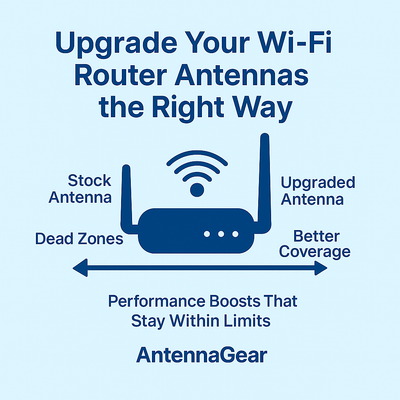Upgrading Wi-Fi Router Antennas: What You Need to Know About EIRP Limits
Posted by Gordon Reed on 19th Aug 2025
Replacing the stock antennas on your Wi-Fi router is a common step for improving range and performance, especially if you live in a multi-level home or deal with signal dead zones. While upgrading to higher-gain antennas can lead to noticeable coverage improvements, there are technical and legal constraints to consider. The primary limitation revolves around EIRP (Effective Isotropic Radiated Power), which governs how much total signal power your router is allowed to radiate.
This post will explore how EIRP works, why it matters, and how to upgrade your router antennas effectively while staying compliant with regulations.
Why Replace Your Wi-Fi Router Antennas?
Most consumer routers come with basic antennas that offer just enough coverage for small homes or apartments. For users who demand better performance, whether for streaming, gaming, or ensuring strong connections in hard-to-reach areas—upgrading to aftermarket antennas can be a game-changer. A well-matched antenna can:
- Improve signal coverage throughout a home or office.
- Reduce dead spots by focusing or enhancing signal strength.
- Provide better performance in environments with interference or dense walls.
AntennaGear offers Wi-Fi antennas designed for popular router models, especially those with RP-SMA or similar standard connectors.
What is EIRP and Why Does It Matter?
EIRP (Effective Isotropic Radiated Power) is the total power your wireless system radiates in a specific direction. It is calculated by combining the router’s transmit power with the gain of the antenna, subtracting any cable losses:
EIRP (dBm) = Transmit Power (dBm) + Antenna Gain (dBi) – Cable Loss (dB).
Regulatory bodies like the FCC in the US or ETSI in Europe set EIRP limits to prevent interference with other devices and networks. For example:
- 2.4 GHz Wi-Fi (802.11b/g/n): Often capped at 36 dBm EIRP (approximately 4 watts).
- 5 GHz Wi-Fi (802.11ac/ax): Typically limited to 30–36 dBm depending on the sub-band.
- 6 GHz Wi-Fi (Wi-Fi 6E): Has stricter limits, often 30 dBm or lower, depending on region.
Exceeding these limits can interfere with other networks and may violate regulations. If you are feeling especially masochistic today, you can read the full FCC regulation here.
How Antenna Replacement Affects EIRP
Replacing your router’s antennas directly affects the EIRP. For instance:
- If your router outputs 20 dBm of power and the stock antenna has 5 dBi of gain, your EIRP is 25 dBm.
- Swapping that antenna for a 12 dBi antenna would raise your EIRP to 32 dBm—potentially exceeding local regulatory limits.
Router manufacturers select stock antennas to ensure the total EIRP stays within legal boundaries. By upgrading antennas, you might inadvertently push the system beyond those limits.
Legal and Safety Considerations
- Regulatory Compliance: In the US, exceeding FCC power limits can result in fines or equipment certification issues.
- Interference Risks: A higher EIRP can cause interference with nearby Wi-Fi networks or other licensed wireless services.
- Warranty Concerns: Modifying your router by changing antennas could void the manufacturer’s warranty.
Performance Limitations Beyond EIRP
While a high-gain antenna can boost range, it doesn’t always improve overall network performance:
- Directional Trade-offs: Higher gain means a narrower beamwidth, which can reduce vertical coverage in multi-floor buildings.
- Router Constraints: The router’s internal power and beamforming capabilities can be limiting factors, even with better antennas.
- MIMO Systems: Modern Wi-Fi routers rely on multiple antennas for MIMO (Multiple-Input, Multiple-Output). Replacing one or more antennas incorrectly can degrade performance.
How to Upgrade Wi-Fi Antennas and Remain Within the Limits
- Choose moderate-gain antennas (e.g., 5–9 dBi) to avoid excessive EIRP.
- Confirm the connector type—many routers use RP-SMA or some variation of a connector in reverse polarity (RP.)
- Focus on antenna placement and environmental optimization (e.g., reducing obstructions) before using extreme antenna gain.
- Use AntennaGear’s Wi-Fi omni-directional and panel antennas, which are designed to improve performance while maintaining compliance.
What This Means for You
Upgrading your router antennas can significantly improve Wi-Fi coverage and signal quality, but you must account for EIRP regulations to avoid compliance issues. AntennaGear offers tested and optimized antenna solutions that provide performance gains without pushing your network beyond safe or legal limits. Whether you’re dealing with poor signal in specific rooms or just want to get the most from your Wi-Fi router, we have the right antenna upgrade for you.
Looking for a reliable Wi-Fi antenna upgrade? Browse AntennaGear’s Wi-Fi antennas designed for routers like Netgear, ASUS, and TP-Link. Our team can help you select the right antenna to improve your wireless coverage—contact us today for expert guidance.

